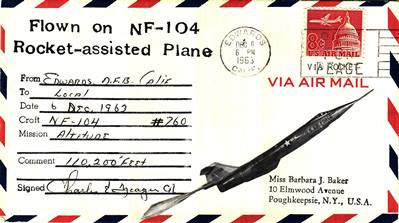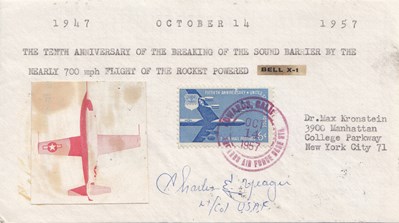Space Cover 449: Rocket-powered supersonic flightOn 14 October 1947, just under a month after the United States Air Force had been created as a separate service, the tests culminated in the first manned supersonic flight, piloted by Captain Charles "Chuck" Yeager in aircraft #46-062, which he had christened Glamorous Glennis after his wife. The rocket-powered aircraft was launched from the bomb bay of a specially modified B-29 and glided to a landing on a runway. XS-1 flight number 50 is the first X-1 to achieve supersonic flight, at Mach 1.06 (361 m/s, 1,299 km/h, and 761 mph peak speed of the XS-1.
Another test pilot, "Slick" Goodlin already had made 26 flights in the Bell X-1 rocket plane and now was slated to make the research aircraft's first supersonic flight, but it never happened. He had requested a flight bonus of $150,000 from Bell Aircraft Company to pilot the test aircraft's unprecedented historic flight. It was an incredible amount of money for a test pilot to request, but it was also an extremely dangerous flight that had never been accomplished. Bell Aircraft managers refused Goodlin's request, and the U.S. Air Force then designated test pilot Captain Charles "Chuck" Yeager to take over the scheduled Bell X-1 test flight to attempt to break the sound barrier.
On October 14, 1947, after dropping from the B-29 mothership that had carried him to flight altitude at 20,000 feet, Chuck Yeager felt his rocket engine kick-in and intently watched his airspeed indicator as he rocketed away and sharply skyward from his B-29 mothership. Yeager watched his instruments intently, and remarked, "Suddenly the Mach needle began to fluctuate. It went up to .965 Mach—then it tipped right off the scale. I thought I was seeing things! We were flying supersonic! And it was as smooth as a baby's bottom…."
Yeager had broken the sound barrier in his Bell XS-1 supersonic aircraft at Mach 1.06, 761 miles per hour, at 20,000 feet altitude, over Muroc Army Air Field, California. For piloting the flight, Yeager was paid his regular Air Force Captain's pay of $3,396 per year. Furthermore, he received no hazardous pay for his flight. That night, celebrating the flight over a pitcher of martinis at the Muroc Air Field Officers' Club, his buddies chided him about his breaking the sound barrier and being "the fastest man alive." But his flight remained classified as top secret until the popular aviation trade magazine Aviation Week broke the story in December 1947. Military officials did not confirm Yeager's top secret, record breaking sound barrier flight until five months later, in May 1948.
By way of historical perspective, with aircraft flying faster and faster in the late 1930's and 1940's, pilots had experienced many problems caused by increased airspeed. High performance aircraft including the Lockheed P-38 "Lightning" and Republic P-47 "Thunderbolt" flew well at operational airspeeds in level flight. In high-speed dives or other high speed maneuvers, though, pilots had experienced aircraft control problems that were unexpected. An aerodynamic condition recognized as "compressibility" was identified as causing this problem.
As the speed of sound was approached, air density increased due to air molecules impinging upon the aircraft and air molecules could not be pushed out of the way fast enough. Shock waves then formed around the aircraft affecting both lift and drag as air speed increased further.
In this early period, air density change due to compressibility was not well understood, and it precipitated loss of aircraft and deaths of test pilots encountering this poorly understood transonic situation.
What made the Bell XS-1 research aircraft different in handling this problem were structural and aerodynamic modifications using extremely thin but strong wing sections and employing horizontal stabilizers that could be adjusted either up or down to improve aircraft control. This XS-1 capability was especially significant at transonic air speeds, that is, speeds near the speed of sound or Mach 1. The XS-1 fuselage additionally was designed to conform to the shape of a Browning .50-caliber bullet with a windscreen also flared to maintain its bullet-like shape.
The supersonic aircraft was occasionally referred to as a "bullet with wings." Additionally, the aircraft carried approximately 500 pounds of test instruments to record flight performance. As a result of Bell Aircraft's innovative aircraft design and operational performance success, follow-on military aircraft manufacturers incorporated similar design modifications including movable horizontal stabilizers as standard aircraft equipment for high performance aircraft.

A subsequent rocket plane flight in NF-104 by Col. Chuck Yeager is shown December 6, 1963, after achieving a rocket plane altitude of 110,200 feet over Edwards Air Force Base, California. The rocket plane test cover is from the collection of Space Unit member Barbara Baker and is EZ catalog vol. 2, USA item 94.
Wishing all of our Space Cover of the Week followers a bright and Happy New Year for 2018! — Steve, SU 4379.













